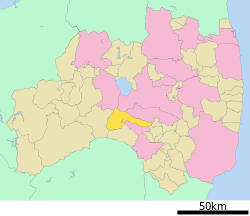Ten-ei, Fukushima
Ten-ei (天栄村, Ten-ei-mura) is a village located in Fukushima Prefecture, Japan. As of 1 January 2020, the village had an estimated population of 5,258 in 1717 households,[1] and a population density of 23 persons per km². The total area of the village was 225.52 square kilometres (87.07 sq mi).
Ten'ei 天栄村 | |
|---|---|
Village | |
 Ten'ei Village Hall | |
Flag Seal | |
 Location of Ten'ei in Fukushima Prefecture | |
 Ten'ei | |
| Coordinates: 37°15′19.4″N 140°14′49.5″E | |
| Country | Japan |
| Region | Tōhoku |
| Prefecture | Fukushima |
| District | Iwase |
| Area | |
| • Total | 225.52 km2 (87.07 sq mi) |
| Population (January 2020) | |
| • Total | 5,258 |
| • Density | 23/km2 (60/sq mi) |
| Time zone | UTC+9 (Japan Standard Time) |
| - Tree | Styphnolobium japonicum, pine |
| - Flower | Gentiana scabra |
| - Bird | Japanese bush warbler |
| Phone number | 0248-82-2111 |
| Address | 78 Shimomatsumoto Harabatake, Ten'ei-mura, Iwase-gun, Fukushima-ken 962-0492 |
| Website | Official website |

Geography
Ten-ei is located in south-central Fukushima prefecture. The village spans the Pacific side of the Abukuma River watershed and the Sea of Japan side of the Agano River watershed across the Ou Mountains. Hatori Dam is located in the village, which supplies agricultural water to the Shirakawa area of the Abukuma River basin and golf courses, campgrounds, skiing around the reservoir. There are many of traditional hot springs in the village.
- Mountains: Futamatayama (1544 m)
- Rivers: Shakado River, Tsurunuma River
Neighboring municipalities
Demographics
Per Japanese census data,[2] the population of Ten-ei has declined steadily over the past 70 years.
| Year | Pop. | ±% |
|---|---|---|
| 1950 | 10,590 | — |
| 1960 | 9,165 | −13.5% |
| 1970 | 7,324 | −20.1% |
| 1980 | 6,820 | −6.9% |
| 1990 | 6,964 | +2.1% |
| 2000 | 6,889 | −1.1% |
| 2010 | 6,291 | −8.7% |
Climate
Ten-ei has a humid climate (Köppen climate classification Cfa). The average annual temperature in Ten-ei is 10.8 °C (51.4 °F). The average annual rainfall is 1,328 mm (52.3 in) with September as the wettest month. The temperatures are highest on average in August, at around 23.8 °C (74.8 °F), and lowest in January, at around −1.1 °C (30.0 °F).[3]
History
The area of present-day Ten-ei was part of ancient Mutsu Province and formed part of the holdings of Shirakawa Domain during the Edo period. After the Meiji Restoration, it was organized as part of Iwase District in the Nakadōri region of Iwashiro Province. The villages of Makimoto, Yumoto, Oya and Hiroto were established on April 1, 1889 with the creation of the modern municipalities system. The village of Ten-ei was formed on March 31, 1955 with the merger of the villages of Makimoto, Yumoto, and a portion of Hiroto with the village of Osato. Many of the houses in the village suffered severe damage from the 2011 Tohoku earthquake.
Economy
The economy of Ten’ei is primarily agricultural, with Yacón a noteworthy crop.
Education
Ten-ei has four public elementary schools and two public middle schools operated by the village government. The village does not have a high school.
- Ten-ei Middle School
- Yumoto Middle School
Transportation
Railway
- Ten-ei does not have any passenger railway service.
Highway
Local attractions
- Hatori Dam
- Futamata Hot Spring
- Yumoto Hot Spring
- Ten’ei Hot Spring
- Hatoriko Hot Spring and ski resort
External links
![]()
- Official website (in Japanese)